Houses
- Birding, Chickens, Gardening adventures, Houses, Living structures, Permaculture and Edible Forest Gardening Adventures
Building a Withy Bird Hide
I was going to continue my series on weeding, but I’ll pick it up next post. Yesterday we received almost an inch of rain. Whoopee! It wasn’t the damaging downpour we had a few weeks ago, either. It was steady and soaking. The temperatures dipped but not to frost (what a strange February!). This morning after I sat clutching my warm tea mug and doing some Internet research, I went outside to check out the yard and it felt like the first day of spring. Cool but not cold. Wet but not soggy. Cloudy and a little threatening but with patches of sunlight. Birds going nuts in all the bushes and trees. It reminded me of our first trip to England during Easter week five years back. There was this feeling, both there and here today of movement everywhere. The soil was stirring with awakening seeds and slumbering creatures.
I put on a knit hat and old clothes and a jacket (ever the lady!) and was all set to pull weeds from the wet ground. Instead I felt inspired to create a bird hide. So, right now you’re thinking of places where birds can hold up. Actually I already have these; they are brush piles all around the fence just for the purpose of providing shelter and escape venues for critters. A bird hide is actually a structure where bird watchers may watch and photograph birds without being seen by them. We have mallards, wigeon and egrets coming to our pond, as well as plenty of songbirds in the surrounding trees. I wanted a bird hide for us and visitors in which to sit and watch.
Since I can’t build anything (the whole measurement thing… I’ve already told you about that) I obtained prices from Quality Sheds in Menifee who built my two sheds so well. Expensive… yep, but not as much as hiring a carpenter, even if he used scraps from my old sheds. Then this morning I started browsing the Internet (trying to stay by that warm teacup as long as possible) and researched withy structures, tree branch structures, living buildings…. all fascinating. Withy is a bendable piece of willow, and sometimes other wood. I’ve always wanted to make a living thing out of willow; stick pieces in the ground, weave together the shoots and it roots and grows! I’ve seen living willow benches before.
So I figured I’d seize the day, this beautiful unofficial start of spring, and see if I could make a decent hide. There are other wonderful structures on the property build by Roger Boddaert and crew, so something natural would not only fit in and be ecologically more sound (than having a structure built), I know the wonderful feeling of being in a structure that is made of natural materials.

The spot. This spot was left untouched during the creation of the garden because somewhere in the area there had been a fairy ring, which is a ring of mushrooms growing out from a central fungus. I’ve given up hope that its still alive, and this is an ideal spot for watching birds both in the pond and in the trees behind.
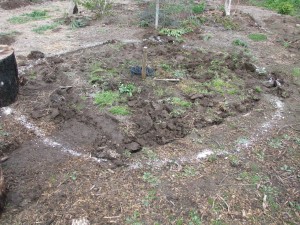
A ten-foot circle. I guessed where the center was, measured roughly five feet (I stepped on the string and held it to my head… I’m 5’3″) and made a ten-foot circle. Why ten? Eight looked too small and twelve too large. I also uncovered the irrigation lines so that I could avoid breaking them (only one casualty).

These logs have to go over there. Old burnt tree stumps had been given to me by Juan, who constructed most of the garden. They’ve been happily growing fungus and providing some habitat as they’ve sat waiting for me to figure out what to do with them. Of course, I wait for the day after a heavy rain when they are good and soaked to move them, and uphill at that! Most of them were old and light enough to roll without too much effort.
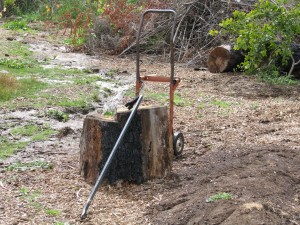
This didn't work. I ended up walking it. Then there was this squat, misshapen devil. It was just oddly shaped enough to not roll, too short and heavy to move with the dolly. Finally I just walked it, bit by bit, curse by curse. I laughed like a madwoman when I put it in place. I’m really glad that I have tolerant neighbors. I often tell my chiropractor about my garden projects. He seems to really like them, and encourages me to keep on hauling flagstone, rolling logs, etc. Hmm.
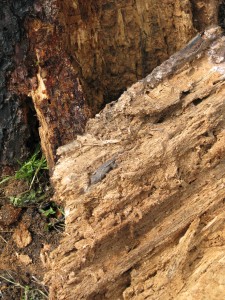
Besides growing interesting fungus, a sleepy lizard was hiding in the log. Of course, right as I position it, some of the back breaks off. There was a sleepy Western fence lizard trying to keep warm.

With some interesting swearing, I tipped it onto my wonderful wagon. Just when I thought I’d moved the heaviest, the last one proved to be a monster. It wouldn’t roll. It wouldn’t wheel. I brought out my incredibly handy garden cart, tipped it up, hoisted that guy onto it and off we went! It wasn’t that easy, but I did it. I had a feeling of satisfaction and accomplishment similar to when I took Tai Kwon Do with my kids, and broke a board with my hand and one with my foot. I felt as if I could chop down walls! Anyway, making this ring felt right, and perhaps their acid decomposition will inspire another mushroom ring.

If Stonehenge caught fire. Then I scavenged for old twisty branches and willow. Although I have native willow growing in the streambed, I opted for curly willow for the sides. Not only is it more architecturally pleasing to my eye, it likes full sun and is more drought tolerant than other willows.
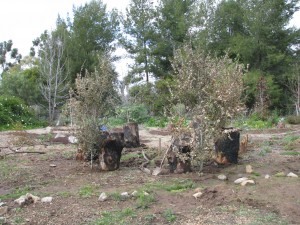
Cut oak trees stuck in for camoflage. Since the willows would just be whips yet, I wanted to kick-start the hide with some camouflage in the form of dead oak trees that hadn’t yet shed their leaves. I stuck them in the mud on either side of the main viewing window. They can be incorporated into the design as the willows grow, or come out easily. Everything is reversible! (I try not to build anything that isn’t).
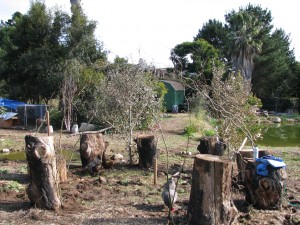
The girls helping me plant the willow withys. I managed to find some long curly willow off of the plants that aren’t even a year old in my garden yet. I want the withys to meet overhead. The ‘windows’ will be over the stumps, except for the main window looking down to the pond. The hens came over to help plant willow by standing on the shovel and in the hole slurping valuable worms. I sure loved the company.

From the entrance. I planted all the willow, but didn’t really finish working on the upper portion before sunset. I really wanted to finish, too, and move on to weeding. Giving the project a little time will help me in finishing it, especially since I’m making it up as I go! I’m not weaving the structure like many willow structures are, but I will be shaping them so that they grow in the right way.

As it looks to ducks. A little anticlimactic, but I’m not done yet! The willow will be growing and filling out with leaves, making the roof canopy all in good time. I bet there are ducks in the pond right now not paying any attention to the hide! 🙂 Tomorrow I might look at it , recoil in horror, and pull everything out. Or not. I’ll let you know.
-
Why Your House is Cold
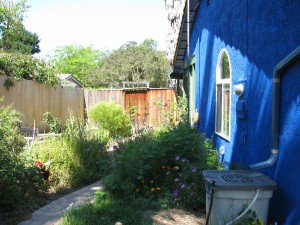
Blue southern wall with window. A friend from China told me that the rule of housebuilding was, “Sit north, face south.” In most areas of China, houses are situated so that the front long wall is facing south, with the short ends facing east and west. She went on to say that when she came to the US she had the hardest time finding her way around because the houses were placed every which way; very confusing.
What would be the reason for placing your house so that it faces south? The sun in winter, rotating lower in the sky, will warm the long portion of your home, the sun shining in your windows brightening the interior and, if you have thought ahead, will warm thermal mass such as a stone floor. In the summer, the sun will be overhead and slightly north. Your roof overhang will protect the house from most of the overhead sun, and when those late afternoon scorching rays hit the west side of the house, it will only affect a narrower wall. Planting trees or trellised vines on that side of the house will further protect from the heat. There is a fifteen-degree difference higher and lower between a house situated north to south as one situated east to west. That is a significant difference in energy savings: it means the difference between turning on the heater or just wearing a heavy sweater, or turning on the air conditioner or opening windows and using a fan.
So, you might wonder, how is my house situated? The wrong way, of course. If I had known about permaculture when I was looking for a house in which to raise my children thirteen years ago, I would have considered the way the house sits on the property and perhaps would not have moved here. Be that as it may, I have made many costly improvements on the house in the last few years, most of which deal with heating and cooling issues. The narrowest wall of the house faces south, and didn’t even have a window in it. The white stucco reflected light so brightly in the summer that it baked the plants in the garden and was impossible to look at without making my eyes water. The summer sun from noon on has been the worst. The western side of the house has three rooms with sliding glass doors (although no view except the yard) and the house bakes in the summer. The heat rises upstairs (it is a split-level) to the bedrooms and into the attic where it sits, making sleeping a challenge in the heat. In the winter, the few hours of weak afternoon sunshine doesn’t warm the house enough, but if those sliding doors were facing south instead, the house could be so much warmer all day. I don’t have and don’t want air conditioning, and don’t like using the propane-fueled forced air heating. There are two fireplaces, both small and in areas where most of the heat goes up the chimney and out the side walls.
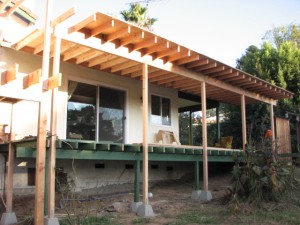
Part of the western side of the house (the rotten porch and overhang was rebuilt) What I’ve done is to replace the windows with energy-efficient glass. That helps, but it also insulates, so a cold house stays cold and a warm house stays hot. If the house had been built facing south, I probably wouldn’t have had to replace the windows at all, but just resealed them. I also painted that glaring southern wall a Mediterranean blue, which I find pleasing and helps keep the plants from cooking. It also helps absorb the heat in the winter. I installed a window on the south side, too, because there are gardens on that side. That helps brighten that room and allows in air and warmth. Thermal curtains are on every window, but I really hate closing them; I like to have the windows uncovered all the time (no really close neighbors). I have to pull them during the hot afternoons and during the cold evenings. I also have pull-down shades on the western porch to block out direct sun before it hits the windows. I installed a whole-house fan, which when turned on sounds as if a helicopter was landing on the roof. How it works is during a heat spell, when there is cool air coming in during the evening you open those doors, close the windows and doors upstairs, and the fan sucks the cold air into the house forcing it through the attic and outside through the air vents. The house cools down inside, the hot air in the attic is replaced by cooler air, and all the cats magically find hiding places you’ll never know about.
One fireplace now has a small wood-burning stove, which does throw more heat into the library but also only takes wood no longer than a foot, which is awkward since most firewood is longer. The other fireplace now has a Grate Wall of Fire http://www.gratewalloffire.com, which is an expensive grate and iron backing which positions the wood so that the embers deliver the heat out into the room rather than up the chimney. I absolutely love this product, and it was worth every penny. It makes lighting a fire easy, safe (the wood doesn’t roll into the room) and worth the effort.
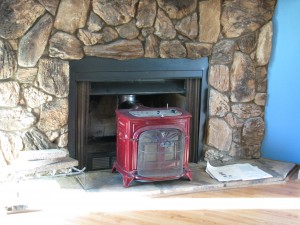
Wood burning stove is cute, but takes tiny logs. My big garage door faces east and is below the bedrooms. During the summer the morning sun hits that door and brings the temperature of the garage to a boiling point, and all that hot air rises to the bedrooms. I’ve put insulation between the support beams of the door and covered it with light plywood. The door won’t open automatically without a helping shoulder (I rarely open it anyway), but that insulation has made a tremendous difference in the temperature.
The house was always very dark inside. During the day I’d have to turn lights on to see. The overhang blocked a lot of sun, but was necessary to.. uh.. block a lot of sun. I installed Solatubes (http://www.solatube.com/) in the upper bathroom, living room, library, kitchen and in my daughter’s room which has no outside windows. What a difference! So much light comes into the house that I can even read without turning on a lamp in the daytime; we still make the mistake of thinking a light is on in the bathroom when it is just the Solatube reflecting out light. They have completely changed the character and feeling of the house to one of brightness and cheer.
The west side of the house is the tallest, where the yard is at level with a crawl-space under the house. When I moved in two huge pine trees blocked the western sun. Of course, within months they contracted a blight and died, and I had to cut them down (that is another story which involves a ladder, a handsaw, a rope, a breeze, and a lucky jump). I’ve replanted a tree which is slowly growing large enough to make a difference to the upper story, but it will also block the main view from the house of my much-improved gardens. Sigh.
If American houses were situated on lots so that they sat north and faced south, the savings in energy consumption from heating and cooling, the consumer savings in purchasing air conditioners, energy-efficient glass, insulation(view here for expert advice), lights, and the high labor costs of contractors would be tremendous. The personal comfort level of the inhabitants would be so much greater than there would be fewer fights and a healthier, more loving and peaceful atmosphere inside. Even with all the expensive changes I’ve made, the house is still hot in the summer and cold in the winter. If only I could pick the whole thing up and turn it forty-five degrees east. I love my house, but energy-efficiency shouldn’t be such a battle.
If you are looking for a house, building a house, or trying to find out why your energy bill is crazy high, take a good look at house placement. Permaculture isn’t just about planting plants, it is about sustainable and natural living.